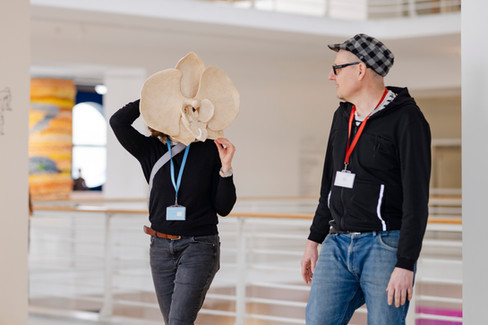Kristýna Říhová
- Česká sekce INSEA

- Jun 28, 2025
- 3 min read
Updated: Aug 28, 2025
3.9 Walking Spaces: Browsing across ATLAS. Territory of Creation and Laboratory of Associative Dreaming (Paper)

Kristýna Říhová – National Gallery Prague, Czech Republic
Marie Fulková – Department of Art Education, Faculty of Education, Charles University, Prague, Czech Republic
Eliška Jelínková – National Gallery Prague | The Academy of Fine Arts in Prague, Czech Republic
Martin Raudenský – Department of Art Education, Faculty of Education, Charles University, Prague, Czech Republic
Kateřina Matějková – National Gallery Prague | The Academy of Arts, Architecture and Design in Prague, Czech Republic
Abstract:
The Walking Spaces case study is one of the results of applied research in the Horizon EU Cultural Literacies' Value in Europe (CLiViE) project, aimed at promoting social justice and inclusion through art education.
We know from previous research that the design of a didactic structure contains relevant temporal and spatial protocols or scenarios. Thus, drawing from Foucault, we explore the dispositif, which we understand as a new composition of time and space in the service of educational aims.
In this context, we have been given a unique opportunity: to explore the educational and social potential of the Studio of Creation and Laboratory of Dreaming (ATLAS), which is located in the National Gallery Prague in the Trade Fair Palace. ATLAS is a specific, low-threshold and open space that steps out of the traditional architecture of galleries and innovatively incorporates a café, playrooms, relaxation areas, a study room and a library. At the same time, it functions as an open platform for workshops, lectures, exercises or friendly meetings, thus going beyond the framework of the gallery as primarily an exhibition space. By its form, ATLAS reflects some of the current tendencies in art theory and art education, which include an emphasis on the openness and inclusiveness of institutions, the use of the social transformational, emancipatory and educational potential of culture or its therapeutic effects on specific communities.
Methodologically, we combine pedagogical action research (PAR) approaches with innovations taken from the CLiViE) project such as Theory of Change (ToC) and SROI (Social Return of Investment). Visual examples of the presentation are taken from the repository of Case Report 4 Walking Spaces, Department of Art Education PedF UK.
Kristýna Říhová – Walking Spaces: Browsing across ATLAS. Territory of Creation and Laboratory of Associative Dreaming
Download:
3.17 Reflection on the History and Mapping the Future (Paper)
Kristýna Říhová – National Gallery Prague, Czech Republic
Alena Kotyza – National Gallery Prague, Czech Republic
Eva Novotná – National Gallery Prague, Czech Republic
Abstract:
The history of museum pedagogy at the National Gallery Prague (NGP) dates back to 1965. This paper explores how educators in the past responded to the gallery’s exhibitions and how the methodology and structure of its educational programs and displays have evolved over time. Drawing on archival research and an analysis of current practices, we will address the following questions: What role did education play at the NGP sixty years ago, and what importance does it have today? Which educational strategies have stood the test of time, and which ones are emerging as innovative approaches? Through specific examples, we will demonstrate how exhibition practices have shifted in response to the so-called “educational turn” and how our programming has adapted to the evolving methodological challenges of recent years. This paper will also share our current vision for gallery education at the NGP, along with the criteria we use to assess its quality. We will reflect on the pressing questions we face today: What purpose does art serve in the gallery context? What do we learn, teach, and discover through it? Our discussion will focus on selected examples from the 19th- to 21st-century collections at the gallery, as well as the role of educational programs for school groups. What areas of knowledge should be explored within school programs, and how can we help make art a natural and essential tool for learning and personal growth?

Download:



















Comments